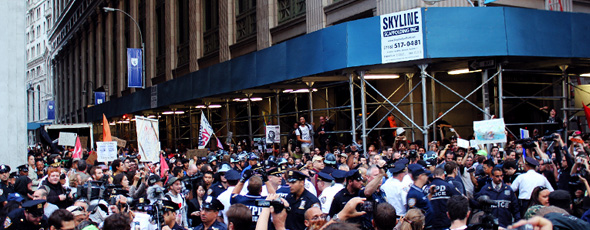
“Shut Down Wall Street” still has a certain ring to it, even one year on. But #S17 was never going to succeed in matching the occupation that came to define last year’s movement, despite a four-figure turnout and a well publicised, wide-reaching plan of action. (Transparency in planning may be a point of principle for a movement seeking inclusivity, but it also goes some way towards letting them know we’re coming…). It is hardly surprising, and far from disappointing, that the fallback from S17-as-action was demonstration, networking and planning among activists still tied to the causes of Occupy, many of whom crossed state lines and national borders to make the day. Myself and other members of the OT collective were among them.
While news of dozens of unwarranted arrests stole the headlines, the real story of S17 and the preceding weekend was one of discussion born out of a year of organising against economic injustice. Many activists involved in the weekend’s action have since pointed to the real value of smaller events such as the September 15 gathering in Washington Square Park; an initial point of meeting and discussion among activists, an open-ended event free from the gravity of ‘significance’ heaped upon the anniversary date of occupation. Beyond the headlines and column inches aiming at the commercially optimal balancing act of at once deriding a ‘dwindling’ movement, whilst simultaneously throwing a congratulatory ‘runner up’ consolation prize to persistent occupiers, these genuine moments of networking were of greater value to the cause. The weekend’s meetings helped keep Occupy moving beyond the restrictive framework defined by its initial tactic (“All day, all week, occupy Wall Street!”) and towards a more versatile incarnation in wide-reaching, networked organisation and grassroots activism in neighbourhoods far away from the financial super-hubs targeted by last year’s occupiers.
I witnessed the reality of this kind of organisation after leaving Wall Street, travelling and crashing with occupiers and activists across some of the country’s Northeast and Midwestern States. In Chicago, way beyond the skyscrapers of the city centre, the El Barrio branch of the Occupy movement continues to organise in the neighborhood of Pilsen, holding regular GAs and actions that are rooted in local causes. In a community where the local jail is a hotspot of activity, occupiers are taking it upon themselves to provide jail support for those on release. Activists meet newly released inmates with water, shoelaces and the offer of a mobile phone for calls to be made to arrange a ride home. In El Barrio, Occupy stands apart from many former city-centre branches by virtue of its members’ ties to the local community, with many occupiers having grown up on the very streets where they now organise.
Why ‘Jail Support’? You only have to scratch the surface of local court activity to get a sense of the injustice felt by those experiencing what passes for law enforcement in Chicago. Cases underway include that of my host, Gary Wagaman, an activist facing allegations relating to his participation in a protest march in solidarity with Quebec’s student movement. Gary, who is pleading innocent, stands accused of throwing an object at an officer, despite multiple eyewitness accounts to the contrary and video evidence debunking numerous claims in the police write-up. If convicted of this felony, he faces a minimum 1-3 year jail sentence. The officer in question was said to have been injured and yet no medical reports have been made available by the prosecution, despite weeks having passed since the protest. Gary’s roommate, Alejandro, points out that his friend’s situation is telling of a wider trend of run-ins with the police in the neighborhoods, vindicating his group’s efforts at the local jail.
In Washington DC, I caught a glimpse of a different form of organisation to Wall Street’s shut down, when an early morning action in the run-up to the Occupy DC’s anniversary targeted various branches of Bank of America across the city in response to foreclosures imposed on homeowners looking to renegotiate their mortgage payments. The more secretive action took the bank by surprise, resulting in a number of closures and disrupted business hours, with no arrests made. The action was undertaken by distinct affinity groups tied to the same cause, but avoided the pitfalls of transparency through more secretive planning, putting the narrative of the action in activists’ hands, and taking the banks by surprise.
Both the organisation and direction of post-occupation activism in Chicago and DC stems from the anticapitalist motivation underpinning the movement, with many occupiers in El Barrio often ready with half-jokes about ‘red state’ interests. Many I talk to about their political stance are sure to identify themselves as anticapitalist, or anarcho-sympathisers. These sentiments were shared by several activists I met with across the northeast, but were best articulated in a conversation I had back in Wall Street, on S17. Among the group of jail support activists waiting throughout the night for the day’s arrestees to be released, I met a twentysomething anarchist involved in zine-making and the distribution of literature spanning Thoreau to Graeber to more recent, group-penned pamphlets on anarchism, civil disobedience and anticapitalism. He recounts that after having taken part in Occupy since the beginning, he stepped back for a while, got a job and an apartment, and started studying journalism, but chose to drop it all and live “off the grid”, as much as possible, occupying his time mostly with activism and non-violent resistance to capitalism.
“Where are you staying tonight?” I asked.
“On the streets.”
By Mark Kauri (@Mark_Kauri)









